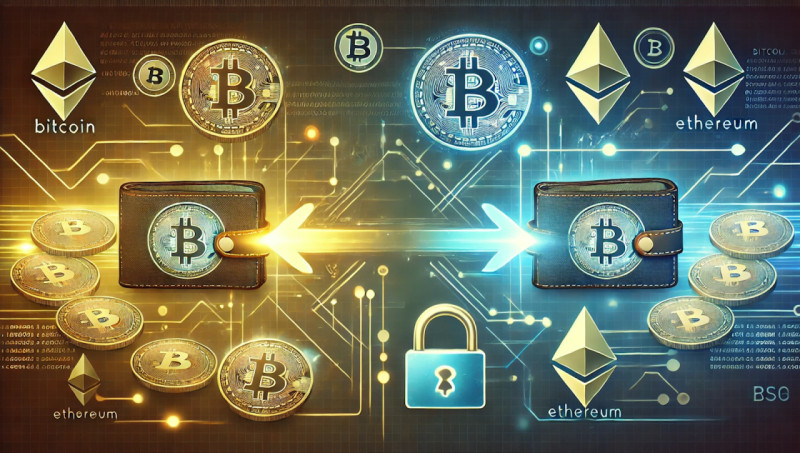
Knowing how to transfer cryptocurrency between wallets is essential in digital finance. While resources like How to Buy Cryptocurrency for Beginners focus on acquiring assets, managing them securely as well as efficiently is equally vital. Whether combining funds, diversifying holdings, or completing payments, precise management ensures safety along with accessibility.
Why Moving Digital Assets Matters
Digital currencies offer freedom, flexibility but demand responsibility. Protecting your holdings goes beyond acquiring them; it requires informed decisions about storage, sending, receiving. Mistakes, like using the wrong address or incompatible systems, can result in irreversible losses. Mastering secure asset management is crucial for preserving value.
Common Scenarios for Moving Funds
- Consolidating holdings. Combining assets from multiple platforms into one location simplifies management. Moving funds to a centralized option with better visibility, protection improves organization as well as security.
- Diversifying holdings. Distributing assets across multiple locations minimizes risk. Combining offline solutions, such as hardware storage, with online platforms ensures security along with liquidity. This strategy balances long-term protection with quick access to smaller amounts.
- Sending payments. Whether paying for goods, settling peer-to-peer trades, or donating, accuracy is crucial. Mistakes, like errors in recipient details or using incompatible systems, can result in complications or loss.
Why Security and Accuracy Are Essential
Blockchain’s irreversible nature means no room exists for mistakes. Unlike traditional systems with dispute resolution or reversals, errors in digital finance are final. Sending funds to an incorrect address or mishandling private keys often leads to permanent loss.
Secure management practices include:
- Double-checking recipient details before initiating any action;
- Using platforms with robust security, such as multi-factor authentication or encryption;
- Avoiding public networks to reduce risks of breaches or unauthorized access.
These steps provide a layer of protection essential for safely managing digital wealth.
The Growing Importance of Preparation
Managing digital assets effectively requires preparation. Factors like fluctuating network fees, variable processing times, different storage systems complicate the process. High network congestion increases costs, while incompatible platforms may delay or block transfers entirely. Knowing best practices ensures smoother operations, safeguards value.
Hook Statement
"Whether you're safeguarding your investments or moving funds, mastering the process of sending cryptocurrency from one wallet to another ensures security as well as efficiency." Clear steps, accurate execution, adherence to best practices simplify digital asset management. By learning these processes, you’re not just protecting holdings—you’re gaining confidence in navigating a rapidly evolving financial system.
Taking the time to grasp these methods empowers you to make informed, secure decisions, enhances your ability to thrive in the digital economy.
Understanding Wallet Types
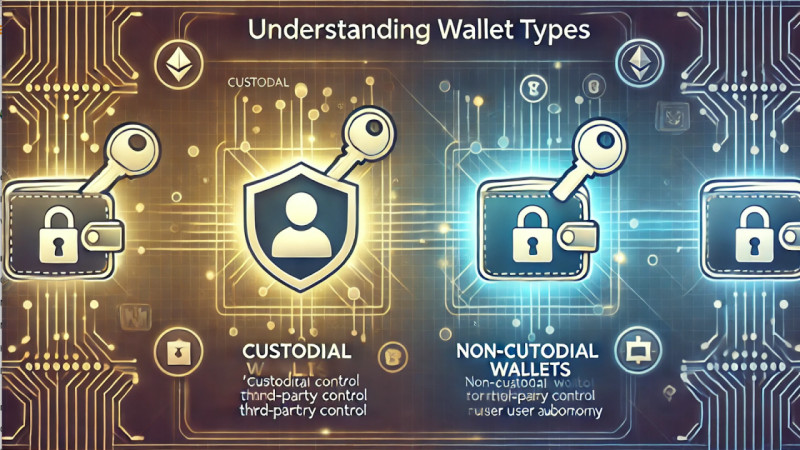
Mastering how to transfer cryptocurrency between wallets starts with recognizing different storage options. Digital storage tools come in various forms, tailored to specific needs, from frequent access to secure, long-term safekeeping. Choosing wisely ensures your digital holdings are both accessible as well as protected.
Hot vs. Cold Wallets
Hot wallets. Hot wallets are connected to the internet, making them ideal for frequent usage. They offer convenience for regular access, are well-suited for tasks such as payments or trading.
Use cases:
- Sending and receiving funds often;
- Managing smaller balances for day-to-day purposes;
- Participating in decentralized finance (DeFi) activities.
| Advantages | Disadvantages | Examples |
| Quick access: hot wallets are ready to use anytime on devices like phones or computers | Higher risk: being online makes them more vulnerable to cyberattacks | MetaMask: popular for Ethereum tokens, compatible with DeFi tools |
| User-friendly interfaces: many include features simplifying asset management | Dependent on user precautions: strong passwords, two-factor authentication (2FA), secure internet usage are necessary | Trust Wallet: versatile mobile option supporting a wide range of tokens as well as NFTs |
| Integration: they work seamlessly with exchanges, decentralized applications |
Hot wallets are great for small amounts of frequent access, but they require vigilance to ensure safety.
Cold wallets. Cold wallets operate offline, prioritizing security over convenience. They’re the preferred choice for safeguarding significant amounts or long-term investments.
Use cases:
- Protecting large balances from online threats.
- Serving as offline vaults for investments.
| Advantages | Disadvantages | Examples |
| Maximum security: being offline shields them from hacking or malware | Less convenient: accessing stored assets requires extra steps | Ledger Nano X: secure hardware option supporting multiple currencies |
| Private key control: full ownership of keys without reliance on external parties | Physical risks: devices must be safeguarded against loss or damage | Trezor Model T: offers top-tier encryption, user-friendly setup |
Cold wallets provide peace of mind for those prioritizing security over accessibility.
Custodial vs. Non-Custodial Wallets
Custodial wallets. These rely on third-party platforms to manage private keys on your behalf. While convenient, they require trust in the service provider.
| Pros | Cons | Examples |
| Easy management: the provider handles technical aspects like backups | Limited control: users depend on the platform for security | Coinbase wallet: pairs smoothly with Coinbase, offering integrated asset management |
| Support services: recovery options are available if account access is lost | Risk of breaches: centralized services may be targeted by hackers | Binance Custodial Tools: built into Binance for easy trading, fund management |
Custodial solutions are perfect for beginners who value simplicity.
Non-custodial wallets. These give users complete control, making them ideal for individuals seeking autonomy.
| Pros | Cons | Examples |
| Ownership: private keys stay with the user, ensuring no external access | Responsibility: users must securely store private keys to avoid losing funds | Exodus: combines ease of use with advanced features for diverse currencies |
| Enhanced privacy: actions remain independent of centralized platforms | Learning curve: setup along with management may require additional knowledge | MyEtherWallet (MEW): designed for direct blockchain interaction with total user control |
Non-custodial wallets suit experienced users focused on privacy, control.
Popular Options for Wallets
Selecting a reliable tool is key for managing digital assets securely. Top recommendations:
- MetaMask – excellent for managing Ethereum tokens, accessing DeFi platforms.
- Ledger Nano X – a trusted cold storage device with broad currency support.
- Exodus: strikes a balance between design as well as functionality, ideal for all users.
Summary
Learning how to transfer cryptocurrency between wallets begins with choosing the right tools. By knowing storage types, you can align your choices with your specific needs. Hot wallets provide accessibility for frequent use, while cold wallets ensure long-term security. Custodial solutions simplify management, non-custodial options prioritize autonomy. Tailoring your strategy to your goals helps protect your assets, enhances your digital finance experience.
Preparing for the Transfer

Effectively managing digital assets requires thorough preparation before initiating any movement. Whether consolidating holdings, enhancing security, or sending funds for purchases, careful planning ensures an efficient, secure, cost-effective process. Mastering the process of sending cryptocurrency from one wallet to another starts with these essential steps.
Verify Compatibility
Ensuring compatibility between sending as well as receiving instruments is crucial to avoid errors or fund loss.
Check asset support. Confirm that both tools accommodate the asset you plan to send. Blockchains function independently, mismatched addresses, such as sending Bitcoin to an Ethereum destination, often result in permanent loss. Always ensure the receiving address corresponds to the specific asset type.
- Example: sending Solana to a non-Solana address leads to irretrievable funds.
- Cross-chain considerations. If bridging between blockchains, verify that the platform supports the conversion, both addresses align with the intended networks. Missteps in cross-chain operations can lead to complications or asset loss.
Multi-asset support. Some tools manage multiple digital currencies, while others focus on specific networks. Review documentation or the interface of your instrument to confirm it supports the asset.
- Pro Tip: Wallets like MetaMask or Exodus simplify this by clearly displaying supported assets.
Spending a few moments verifying compatibility prevents errors, ensures funds remain secure.
Manage Fees
Blockchain operations incur fees that vary based on network activity. Awareness of these costs helps you plan efficiently.
How fees work. Fees incentivize validators or miners to confirm, secure transactions. Networks like Ethereum charge "gas fees," which depend on network demand, computational requirements. Peak usage, such as during high-profile market events, increases costs significantly.
Examples of Fee Structures:
- Bitcoin: Costs depend on data size along with priority.
- Ethereum: Gas prices fluctuate with congestion.
- Solana: Low-cost network with minimal fees, ideal for frequent transfers.
Tips to Reduce Costs:
- Track network activity. Use tools like ETH Gas Station (Ethereum) or Mempool.space (Bitcoin) to monitor real-time congestion;
- Adjust speed preferences: many platforms allow manual fee settings, offering fast, medium, or slow speeds. Opt for slower speeds if time is less critical;
- Batch operations: consolidating multiple movements into one reduces cumulative expenses.
Planning transfers during off-peak periods, monitoring conditions preserves your assets while minimizing costs.
Secure Internet Usage
The quality of your internet connection impacts the safety of your digital asset activity. Protecting this gateway ensures privacy, prevents unauthorized access.
Avoid public connections. Public Wi-Fi, commonly found in airports or cafes, exposes sensitive information to interception. These networks often lack sufficient encryption, making them targets for cybercriminals.
- Best Practice: Use private, password-protected internet connections when managing assets.
Leverage VPNs. A Virtual Private Network (VPN) adds a layer of encryption, creating a secure environment for online activities. VPNs mask your IP address, encrypt transmitted data, preventing third-party interference or tracking.
- Benefits of VPNs for those who want to know how to transfer cryptocurrency between wallets:
- Conceal your location;
- Encrypt communication, reducing exposure to threats;
- Add an extra layer of security on unsecured networks.
Maintain Updated Devices. Outdated software or operating systems increase vulnerability to malware. Regular updates, antivirus tools protect against evolving threats.
- Pro Tip: Pair antivirus software with a VPN for comprehensive security.
Secure connections safeguard your assets, reduce risks during digital operations.
Proactive Measures for Smooth Processes
- Verify details: always confirm recipient addresses, asset types before proceeding. Errors can result in permanent loss.
- Test first: for unfamiliar platforms, start with a small test amount. This ensures compatibility as well as builds confidence in the process.
- Enable 2FA: two-factor authentication (2FA) adds an extra layer of security, protecting against unauthorized access.
Preparation is key to avoiding complications. By ensuring compatibility, monitoring fees, prioritizing secure environments, you minimize risks as well as create a smooth experience. These measures protect your holdings, provide confidence for future operations.
Step-by-Step Guide: How to Transfer Cryptocurrency
Efficiently moving digital assets requires precision, attention to detail. Whether consolidating holdings, paying for services, or sending funds, a clear process helps prevent errors, delays, or loss. Mastering the process of moving digital assets between wallets ensures a seamless, secure experience. Here’s a detailed breakdown of the key steps.
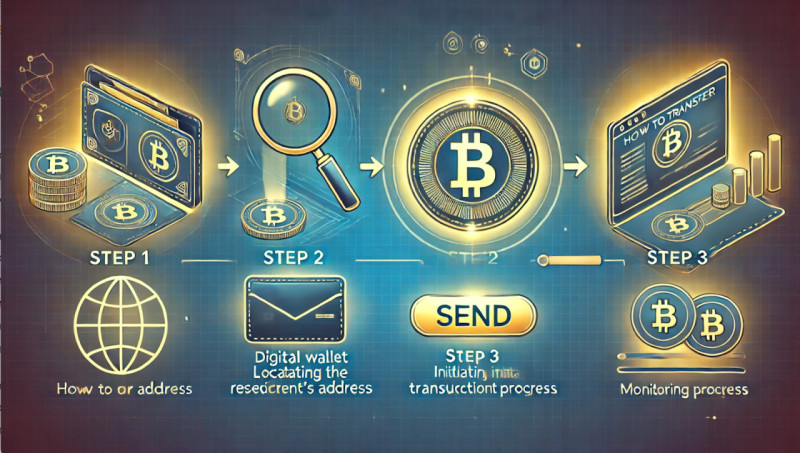
Step 1: Locate the Recipient’s Address
The recipient’s address serves as the destination for your funds. It is unique to their platform or device, its accuracy is essential.
Request the address. Ask the recipient for their address through secure channels. Most platforms display this prominently, many offer QR codes to simplify the process.
- Examples of address formats:
- Bitcoin (BTC): starts with "1," "3," or "bc1.";
- Ethereum (ETH): begins with "0x," followed by 40 alphanumeric characters;
- Other assets: each blockchain has unique address formats. Always verify compatibility with the asset you are sending.
Avoid manual entry. Manually typing addresses increases the chance of errors. Instead:
- Copy and paste: copy the address directly to avoid typos;
- Scan QR codes: use built-in scanners in apps for faster, error-free input.
Verify accuracy.Mistakes in addresses are almost always irreversible. To avoid errors:
- Double-check the address by comparing the first and last few characters;
- Confirm the address is correct for the asset you’re sending. For instance, Bitcoin sent to an Ethereum address will be permanently lost.
Spending time verifying details at this stage prevents critical errors later.
Step 2: Initiate the Process
Once the recipient's address is ready, initiate the movement by inputting details, setting fees, confirming all information.
Input address, amount
- Enter the address: paste or scan the recipient’s details into the designated field.
- Specify the amount: enter the exact amount. Some platforms display a fiat equivalent to help confirm accuracy.
Set network fees. Blockchain networks require fees to incentivize validators or miners. Most platforms offer fee options:
- High priority: faster confirmation for urgent situations; higher cost.
- Standard: balanced speed along with cost, ideal for most users.
- Low priority: cheapest option but slower during busy times.
If time isn’t critical, selecting standard or low-priority fees saves money for those who know how to transfer cryptocurrency between wallets effectively.
Review, authenticate. Before finalizing:
- Verify the recipient’s address along with amount;
- Check the selected fee;
- Authenticate the process using security features like PINs, passwords, or two-factor authentication (2FA).
Careful review reduces risks, ensures the accuracy of the process.
Step 3: Monitor Progress
After confirmation, monitor the progress to ensure smooth completion, address potential delays.
Confirmations explained. Each network requires a certain number of confirmations to finalize transfers:
- Bitcoin: usually 3–6 confirmations;
- Ethereum: around 12 confirmations;
- Other networks: vary based on the blockchain; consult documentation.
Confirmations represent blocks added to the blockchain after your request, securing the transfer in the ledger.
Use blockchain explorers. Track progress in real time:
- Bitcoin: use Blockchain.com to check your transaction ID (hash);
- Ethereum: use Etherscan to view confirmation counts as well as fees.
Explorers provide detailed updates, including estimated processing times, transaction costs.
Enable Notifications. Many platforms send updates when processing is complete. Enable notifications to stay informed without manually checking progress.
Additional Tips for Smooth Execution
- Double-check all details. Errors in the recipient's address or network type are irreversible. Spending extra time reviewing ensures accuracy.
- Avoid high traffic. Network congestion increases fees as well as delays. Fee trackers like ETH Gas Station or Mempool.space help identify optimal times for faster processing.
- Keep backup records. Save the transaction ID for troubleshooting or future reference. This is especially useful for resolving delays or disputes.
Building Confidence in Asset Management
Following these steps provides confidence, minimizes risks when managing digital funds. By double-checking recipient details, selecting appropriate fees, monitoring progress, you can move assets securely. Whether consolidating holdings, securing investments, or sending payments, mastering the process of sending cryptocurrency from one wallet to another empowers you to navigate digital finance with ease.
Common Challenges, How to Solve Them
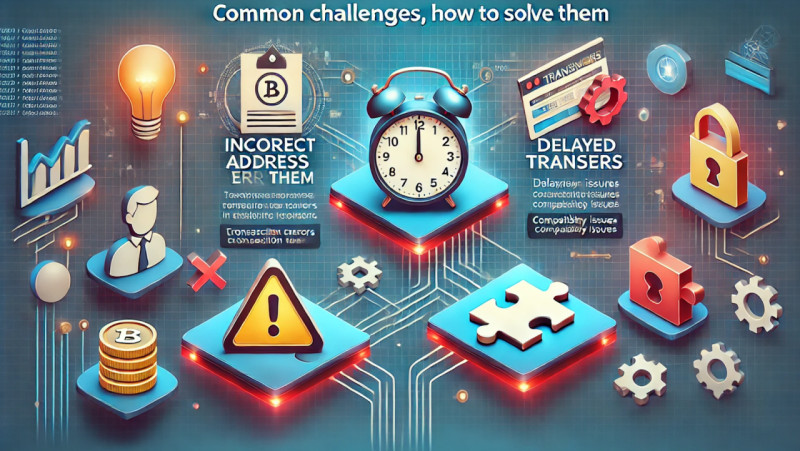
Managing digital assets requires precision, as minor mistakes can lead to delays, extra fees, or loss. Identifying common challenges, implementing solutions ensures smoother processes, especially when mastering the procedure of moving digital assets between wallets. Here are key obstacles and effective ways to address them.
Incorrect Address Errors
Risks. Mistakes with destination addresses are among the most serious issues, as blockchain processes are final. Errors can result in funds going to unintended recipients or being lost if the address doesn’t correspond to a valid account.
- Human error: manually entering long alphanumeric strings increases the likelihood of typos.
- Wrong asset type: sending funds to an incompatible address (e.g., Bitcoin sent to an Ethereum account) often leads to permanent loss.
Solutions:
- Double-check details: verify the first and last few characters of the address before confirming. Most platforms highlight these for easy validation.
- Use QR codes: scan codes instead of typing or pasting addresses manually. This method reduces errors, ensures precision.
- Test with small amounts: when sending large sums, begin with a small transfer to validate compatibility along with accuracy.
By taking these precautions, you significantly reduce the risk of sending funds to incorrect locations, so you know how to transfer cryptocurrency between wallets.
Delayed Transfers
Causes.Processing delays often stem from a few predictable factors:
- Network congestion: high activity on popular blockchains, like Bitcoin or Ethereum, slows confirmations. Miners prioritize transactions with higher fees;
- Low fees: insufficient fees can leave transfers unconfirmed for extended periods;
- Platform reviews: centralized services may hold transfers for manual checks, especially with large amounts or compliance concerns.
Solutions:
- Optimize fees: adjust fees based on current network traffic. Platforms often provide options like "low," "standard," or "high." Higher fees ensure quicker processing during busy periods.
- Monitor progress: use tools like Etherscan or Blockchair to track status by entering the transaction hash. These explorers show whether transfers are pending, confirmed, or require action.
- Plan around traffic: avoid periods of high congestion, such as during market volatility or blockchain upgrades. Fee trackers can help identify quieter times for smoother processing.
With proper planning, delays can often be avoided or minimized.
Compatibility Issues
Problems. Compatibility challenges arise when moving digital assets between systems that don’t align, causing errors or loss:
- Unsupported assets: some wallets only handle specific assets, like Bitcoin, won’t accept others like Ethereum.
- Blockchain mismatches: sending tokens across incompatible networks (e.g., Binance Smart Chain tokens sent to an Ethereum account) can render them irretrievable.
Solutions:
- Research support: check if the receiving platform supports the asset. Most list compatible tokens in their documentation or app interfaces.
- Select the correct network: assets like stablecoins can exist on multiple blockchains. Confirm both sender and recipient are using the same network (e.g., Ethereum or Binance Smart Chain).
- Consult support: if unsure, ask the recipient or platform for guidance on compatibility as well as settings.
Ensuring compatibility keeps funds secure, directed to the intended location.
Proactive Steps for Smooth Transfers
- Verify every detail. Double-check addresses, amounts, network types before confirming. This reduces the chance of errors.
- Stay updated. Monitor network conditions, including fees and congestion, to anticipate potential delays or costs.
- Maintain records. Save transaction IDs or confirmation hashes. These details are invaluable for tracking along with troubleshooting.
Confident Asset Management
Addressing common challenges, adopting preventive measures helps you manage digital assets effectively. Whether consolidating holdings, securing funds, or making payments, mastering the procedure of sending cryptocurrency from one wallet to another ensures smooth, secure operations while protecting investments.
Best Practices for Secure Transfers
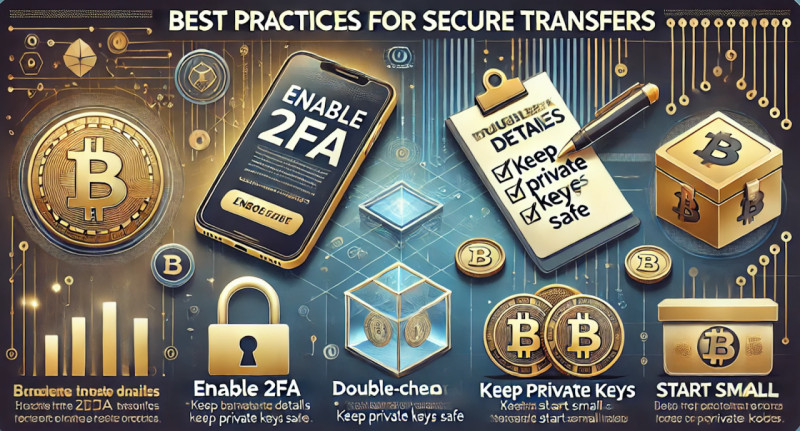
Protecting digital assets during transfers is essential to prevent loss or unauthorized access. Whether moving funds for safekeeping, consolidating accounts, or completing payments, following best practices ensures a secure, seamless experience. Mastering the process of moving digital assets between wallets involves more than technical knowledge — it requires proactive measures to avoid errors, mitigate risks.
Enable Two-Factor Authentication (2FA)
Adding 2FA enhances account security by requiring an extra verification step beyond your password.
- Why it’s important. 2FA reduces the risk of unauthorized access, even if login credentials are compromised. With app-based 2FA, such as Google Authenticator, users enter a time-sensitive code generated on their device.
- Setting it up:
Access the security settings of your chosen platform.
Choose app-based 2FA instead of SMS to avoid vulnerabilities like SIM swapping.
Link the authenticator app, securely save backup codes in case of lost access.
- Extend 2FA. Ensure both sending as well as receiving platforms or accounts have 2FA enabled for an added layer of protection.
This extra step significantly reduces the chances of unauthorized access during transfers for those who want to know how to transfer cryptocurrency between wallets.
Double-Check All Details
Accuracy is critical when managing digital assets. Even minor errors can lead to irreversible loss.
Verify addresses
- Carefully review the first and last characters of the recipient's address. Most platforms display these for easier confirmation.
- Use QR codes to eliminate the risk of typographical errors. Scanning ensures the address is exact.
Review amounts
- Double-check the amount to send, ensuring the decimal placement is correct. Sending too much or too little can cause issues.
- Be aware of platform-imposed limits, which may reject or delay transfers exceeding thresholds.
Confirm network types
- Choose the correct blockchain network for assets available on multiple chains (e.g., Ethereum or Binance Smart Chain).
- Sending funds across incompatible networks often leads to permanent loss.
Paying attention to every detail minimizes errors, ensures successful transfers.
Keep Private Keys Safe
Private keys are the foundation of digital asset security, granting full control over funds.
- Why keys matter. Private keys provide access to your holdings. If shared, anyone with the key can access, move your funds without your consent. During transfers, there’s no valid reason to disclose private keys.
- Secure storage:
- Store private keys offline, using hardware devices or encrypted storage.
- Create backups, such as writing keys down, storing them in a secure location, like a safe.
- Avoid storing keys in cloud services or online documents, which are vulnerable to hacking.
Proper management of private keys ensures complete control over assets, eliminates risks.
Start Small
Testing with small amounts minimizes risks, builds confidence in the transfer process.
- Why it helps. A small initial transfer confirms the accuracy of recipient details, network settings without exposing large amounts. It’s especially useful when using a platform for the first time.
- How to test:
Send a small, affordable amount to the recipient’s address.
Verify the funds arrive correctly, in the intended currency.
Proceed with the full transfer only after successful confirmation.
This approach protects against errors during high-value transfers.
Summary of Best Practices
- Enable two-factor authentication: add extra verification for better security.
- Double-check details: verify addresses, amounts, network types.
- Protect private keys: keep keys offline, never share them.
- Start small: test with a small amount before making larger transfers.
Applying these steps ensures you not only know the process of sending cryptocurrency from one wallet to another but can do so confidently as well as securely. By prioritizing security, accuracy, caution, you build a reliable framework for managing digital assets with minimal risk.
Legal, Tax Considerations
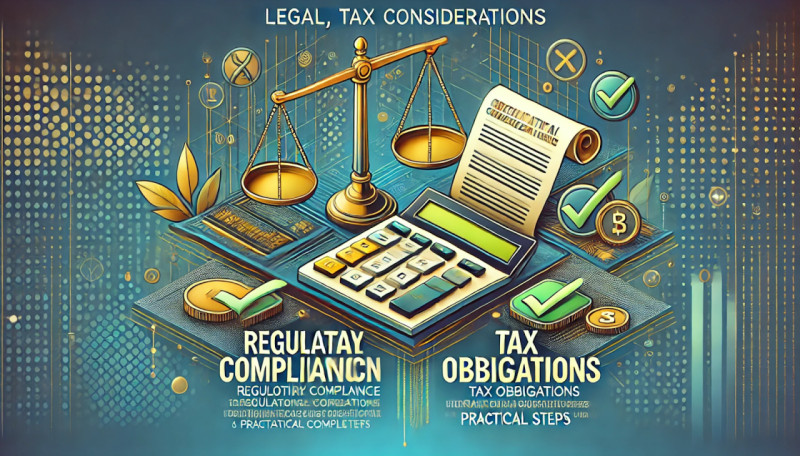
Managing digital assets requires more than technical skills — it also involves navigating legal issues along with tax responsibilities. Mistakes in these areas can lead to penalties or financial setbacks. Knowing the procedure of moving digital assets between wallets while staying compliant ensures a smooth, secure process.
Regulatory Compliance
Regulations for digital assets vary by region. Moving funds domestically or internationally requires awareness of these rules.
Local Rules
Licensing requirements. Some jurisdictions require platforms facilitating digital asset movements to hold specific licenses, ensuring compliance with anti-money laundering (AML), know-your-customer (KYC) laws.
Reporting thresholds. Certain countries mandate reporting transfers exceeding a specific value. For example, U.S. law requires reporting transactions over $10,000 under the Bank Secrecy Act.
Platform restrictions. Some governments limit access to platforms or impose restrictions on international transfers. Ensure the services used are legally permitted within your jurisdiction if you want to master how to transfer cryptocurrency between wallets legally.
International Transfers
Cross-border rules. Sending digital assets abroad may trigger additional scrutiny or fees. Research regulations in the recipient’s country to prevent delays or confiscation.
Currency conversion. If converting digital assets into fiat during the process, consider exchange rate fluctuations, associated service fees.
Sanctioned regions. Some countries are under international sanctions, restricting transfers involving entities or individuals in those areas. Verify that your actions comply with trade restrictions.
Adhering to these rules protects your assets, ensures legality when moving funds.
Tax Obligations
Many countries classify digital asset movements as taxable events. Non-compliance can lead to audits or fines.
Taxable Events
- Gains and losses. When learning the process of sending digital assets from one wallet to another without converting to fiat, the act itself often isn’t taxable. However, selling, exchanging, or converting assets may trigger reportable gains or losses.
- Gifting and inheritance. Sending digital assets as gifts may require valuation as well as reporting. Similarly, inherited digital holdings could be subject to estate taxes in certain jurisdictions.
- Business Transactions. Using digital funds to pay for goods or services is often taxable. The value of assets at the time of payment must be reported.
Record-Keeping
- Detailed logs. Maintain clear records of each transfer, including dates, amounts, recipient details, fees. For blockchain actions, keep transaction IDs.
- Tracking tools. Use portfolio management apps to automate tracking, calculate tax obligations. Many integrate with platforms to streamline reporting.
- Professional guidance. Consult tax professionals familiar with digital assets. They can clarify complex situations like cross-border transfers or special tax treatments.
Accurate records simplify tax compliance, reduce potential issues during audits.
Practical Compliance Steps
Navigating legal, tax obligations doesn’t have to be overwhelming. These steps keep you compliant as well as informed:
Research local rules. Know regulations in your jurisdiction, including reporting thresholds along with tax requirements.
Verify platform legitimacy. Ensure platforms used are licensed, comply with regional laws.
Document every movement. Maintain detailed records of all actions, including transaction IDs, amounts, fees.
Stay updated. Laws evolve rapidly. Subscribe to updates or consult legal, tax advisors to remain informed.
Conclusion
Mastering the procedure of moving cryptocurrencies between wallets involves more than technical steps. Legal as well as tax considerations are critical to safeguarding investments, ensuring smooth processes. Compliance with regulations, accurate reporting, thorough record-keeping minimize risks, support long-term success. With awareness and preparation, digital asset management becomes a secure, legally sound practice.
Frequently Asked Questions
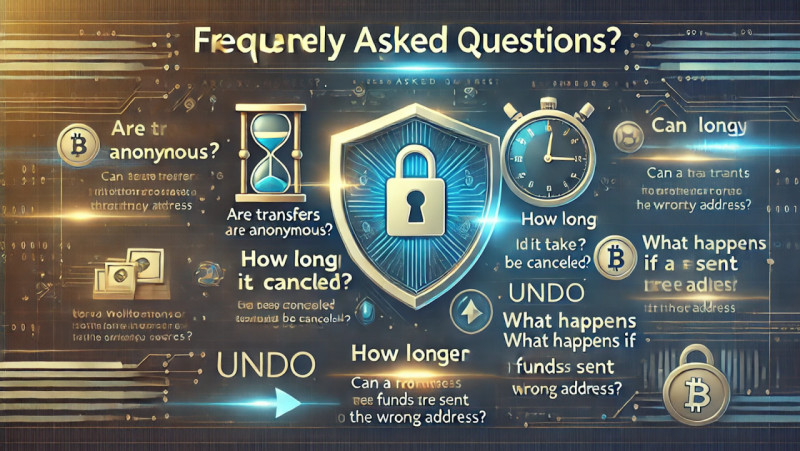
Navigating digital assets often raises questions, especially when learning the process of sending digital assets from one wallet to another. Clear answers, actionable strategies ensure a smoother experience while avoiding common pitfalls. Here’s a guide to help you manage the process confidently.
How Long Does It Take to Move Funds Between Wallets?
Transfer times depend on several factors, including blockchain specifics, fee settings, platform policies.
Blockchain confirmation times:
- Bitcoin: typically takes 10–60 minutes based on network traffic, confirmation requirements.
- Ethereum: processing can take minutes, though delays during high demand, such as NFT drops, may extend to hours.
- Other blockchains: networks like Solana or Polygon are optimized for speed, often completing transactions within seconds or minutes for those who want to know how to transfer cryptocurrency between wallets quickly.
Factors influencing speed:
- Fee priority: higher fees incentivize faster processing by miners or validators. Most platforms allow you to select fee levels like standard, fast, or priority.
- Network congestion: popular networks may slow significantly during peak activity. Checking blockchain explorers helps gauge real-time conditions.
- Platform delays: services like exchanges may impose additional processing for security checks or large amounts.
Timely planning, proactive measures, such as adjusting fees, help reduce delays, especially during high-traffic periods.
Are Transfers Anonymous?
Transfers offer pseudonymity but not full anonymity. Privacy depends on the blockchain, management of funds.
Pseudonymity on Public Blockchains
- Transparency: networks like Bitcoin or Ethereum display transaction details, including amounts, addresses. While these addresses don’t directly reveal identities, linking them to exchanges or personal data compromises privacy.
- Address reuse: reusing addresses across transactions allows easier tracking. Generating unique addresses for each transaction enhances privacy.
Enhancing Privacy
- Privacy-centric networks: platforms like Monero or Zcash obscure transaction details, offering greater anonymity.
- Mixing services: tools like Tornado Cash anonymize funds by pooling them. However, such services may face legal restrictions in some jurisdictions.
- Avoid custodial solutions: using non-custodial services avoids linking personal details to your assets.
Combining these practices helps strengthen privacy beyond what pseudonymity alone provides.
Can a Transfer Be Canceled?
Once processed, blockchain transactions are irreversible due to their immutable design.
Why Blockchain Transfers Can’t Be Altered
- Irreversibility: Blockchain technology ensures permanence to prevent tampering. Once validated, changes are impossible.
- Pending Transactions: In rare cases, unconfirmed transactions allow adjustments, such as increasing fees to prioritize processing. Complete cancellations, however, are not feasible.
Mitigating Risks
- Verify details thoroughly: double-check recipient address, amount, network type before sending funds.
- Perform test transfers: send a small amount first to confirm accuracy, compatibility.
Taking precautions reduces risks, ensuring smoother transactions.
What Happens If Funds Are Sent to the Wrong Address?
Mistakenly sending assets to an incorrect address is a common yet serious error. Recovery depends on the circumstances.
Address Issues
- Invalid address: transfers to invalid addresses typically fail, keeping funds in your account.
- Wrong address: if sent to a valid but incorrect address, recovery depends on the recipient's willingness to cooperate, which is rare.
Recovery Steps:
- Same platform: contact support if both sender and recipient use the same service. Immediate action improves chances of recovery.
- Supported networks: some wallets or platforms have recovery tools for specific networks or tokens, though these options are limited.
Prevention Strategies
- Use test transfers: send small amounts first to confirm recipient details.
- Avoid manual input: use QR codes or copy-paste to eliminate typographical errors.
Prevention remains the best defense, as recovery options are minimal, often out of your control.
Proactively Addressing Challenges
Mastering the procedure of sending cryptocurrency from one wallet to another means anticipating potential issues, applying preventive measures. By comprehending typical delays, safeguarding privacy, verifying all details, using test transfers, you reduce risks significantly. These proactive steps ensure secure, efficient management of digital funds while building confidence in your ability to navigate the evolving landscape of digital finance.
Advanced Tips for Experienced Users
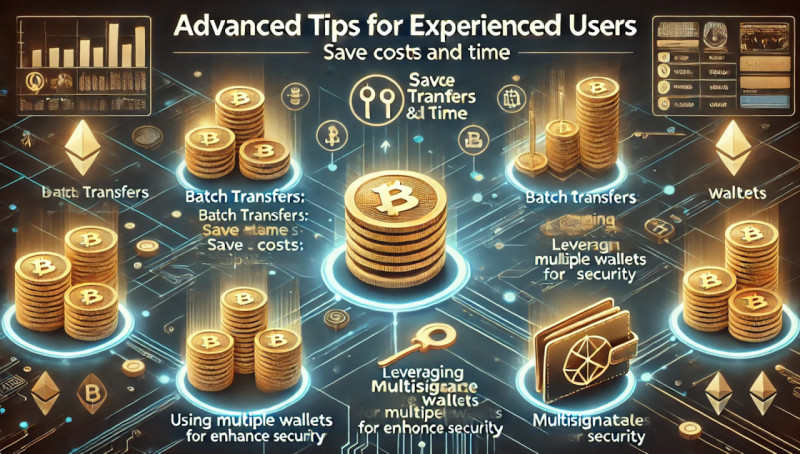
Moving digital holdings effectively involves advanced methods to enhance security, reduce costs, and streamline processes. Techniques such as batching, diversifying assets, and implementing multi-signature systems offer powerful tools for experienced users. Mastering how to transfer cryptocurrency between wallets with these approaches minimizes risks,and improves efficiency.
Batch Transfers: Save Costs and Time
Grouping multiple operations into one reduces both fees as well as effort, especially during periods of high network activity.
How batch transfers work:
- Consolidation: combine multiple actions into a single operation rather than processing each individually. This approach benefits businesses, frequent traders, users managing multiple accounts.
- Fee efficiency: fees on most blockchains depend on data size, not the number of recipients. Batching reduces overall costs by optimizing network usage.
When to use batch transfers
- Portfolio organization: consolidate holdings from various accounts into primary storage for easier management.
- Mass payments: ideal for companies managing payroll or payments to multiple contractors or recipients.
- Asset diversification: efficiently distribute funds across multiple security solutions.
Tips for batching
- Use tools that support batch functionality, such as Electrum or Bitcoin Core.
- Schedule operations during off-peak hours to minimize fees further.
- Double-check all recipient details to avoid errors affecting the entire batch.
Batch transfers simplify complex operations, save costs, making them invaluable for users managing multiple assets.
Using Multiple Wallets to Enhance Security
Dividing holdings across multiple systems protects against vulnerabilities as well as ensures better fund management.
Benefits of diversifying assets
- Risk mitigation: distributing funds reduces exposure to single points of failure, such as hacks or lost devices.
- Purpose-specific allocation: use different systems for daily spending, long-term savings, trading to keep operations organized.
- Limited exposure: storing smaller amounts in each system minimizes potential losses.
Recommended setup
- Hot wallets: keep smaller amounts in internet-connected systems for frequent actions. Prioritize tools offering strong encryption, two-factor authentication (2FA).
- Cold wallets: use offline solutions like hardware wallets (e.g., Ledger, Trezor) or air-gapped devices for larger holdings. These options provide maximum security.
- Mobile wallets: lightweight solutions on smartphones are convenient for small, everyday payments.
Enhancing security
- Regularly update software, firmware to prevent vulnerabilities.
- Back up recovery phrases or encrypted files in secure, offline locations.
- Avoid reusing addresses to enhance privacy, minimize tracking.
Diversifying systems strengthens security without compromising usability.
Leveraging Multisignature Wallets for Advanced Protection
Multisignature (multisig) systems require multiple approvals for fund movements, adding an extra layer of security for high-value assets.
How Multisig Works
- Approval thresholds: set the number of required signatures, such as 2-of-3 or 3-of-5, to authorize movements. This setup ensures no single party has full control.
- Distributed access: each participant holds a private key, decentralizing authority, safeguarding funds.
Use Cases for Multisig
- Business accounts: organizations use multisig to prevent unauthorized activity by requiring approvals from multiple stakeholders.
- Shared investments: families or groups managing assets collaboratively benefit from distributed control.
- High-security savings: long-term holders integrate multisig into their offline systems to mitigate single-point risks.
Setting Up Multisig
- Choose a provider supporting this feature, such as Electrum, Casa, or BitGo.
- Define signer roles, approval requirements during setup.
- Secure private keys across multiple trusted locations or individuals.
Advantages
- Protects against theft, even if one private key is compromised.
- Distributes authority, reducing dependence on centralized platforms.
- Enhances accountability for businesses, shared funds.
Multisig systems offer unparalleled security for significant holdings or collaborative asset management.
Empowering Secure Asset Management
Advanced strategies such as batching, diversifying, using multisig systems elevate digital fund handling to a professional level. Applying these methods ensures you not only master how to transfer cryptocurrency between wallets but do so with maximum security along with efficiency. These tools empower experienced users to optimize operations, protect holdings, navigate the complexities of digital finance with confidence.
Conclusion
Managing digital holdings requires planning, precision, a focus on security. Whether consolidating investments, diversifying funds, or making payments, every step counts. Mastering the process of moving digital assets between wallets is an essential skill for navigating the digital economy confidently.
Recap of Key Points
Preparation is essential. Thorough preparation ensures smooth operations. Confirm that both sender as well as receiver systems support the same asset type, avoiding compatibility issues. Being aware of fees, timing operations during low network activity helps minimize costs. Always use secure internet connections to protect sensitive information.
Security comes first. Safeguarding digital holdings requires a proactive approach. Enable two-factor authentication (2FA) to add an extra layer of protection. Verify recipient details carefully—mistakes in addresses or amounts can lead to permanent losses. For large transfers, always start with a small test amount to confirm systems work correctly before proceeding.
Advanced strategies for efficiency. Seasoned users who know the process of moving digital assets between wallets can leverage advanced methods:
- Batch transfers: reduce costs by consolidating multiple transfers into one operation. This is ideal for frequent movers or businesses.
- Multisignature solutions: require multiple approvals for high-value assets, enhancing security for collaborative accounts.
- Diversification: spread funds across secure platforms, offline systems like cold wallets to reduce risks from potential breaches.
These methods optimize processes while maintaining high security standards.
Legal compliance, staying informed. Adhering to tax as well as legal requirements is essential. Laws around digital assets vary, so staying informed about local regulations ensures compliance, avoids penalties. Maintain detailed records of each transfer, including dates, amounts, recipient information, to simplify tax reporting, resolve potential disputes.
Troubleshooting Challenges
Even with careful planning, issues may arise. Addressing these proactively ensures minimal disruption:
- Delayed confirmations: use blockchain explorers to track progress, check the status of pending transfers.
- Incorrect details: double-check all inputs before sending. Mistakes in addresses or asset types can result in lost funds.
- Network issues: stay updated on network conditions, adjust fees to expedite processing when needed.
Being prepared for potential challenges ensures confidence, control during operations.
Building Confidence Through Knowledge
Mastering the procedure of sending cryptocurrency from one wallet to another securely, efficiently empowers users to manage assets with assurance. From verifying compatibility to employing privacy measures, each step contributes to a streamlined process. By minimizing risks, avoiding errors, optimizing methods, you maximize the value of your holdings while maintaining peace of mind.
Digital finance offers immense opportunities but requires responsibility. Embracing best practices helps protect investments while fostering confidence in managing assets. Accuracy, security, preparation form the foundation of successful operations, enabling smooth navigation of the digital finance landscape.
Call to Action
Take charge of your digital assets today. Start applying these strategies, adopt routines that emphasize secure, efficient practices. Whether new to digital finance or refining your approach, mastering how to transfer cryptocurrency between wallets is essential for financial empowerment. Follow these principles to protect your holdings, enhance your skills, move forward with confidence in the growing digital economy.
Recommended
How to Mine Cryptocurrency on PC
How to Mine Cryptocurrency on iPhone
How to earn interest on cryptocurrency
How to invest in cryptocurrency
















